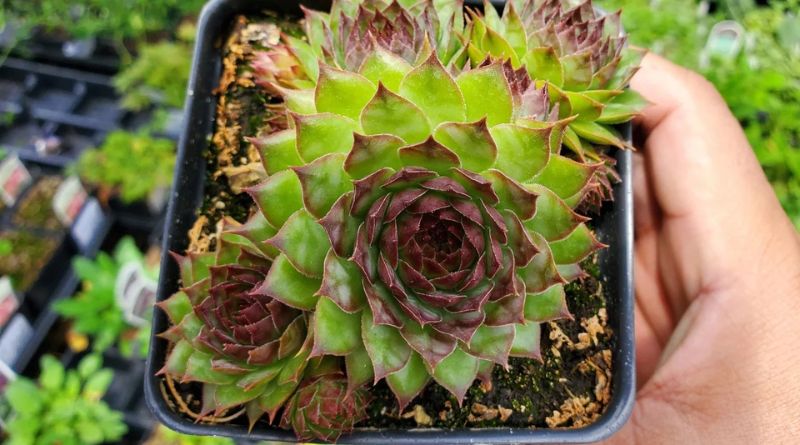The Hen and Chicks plant (scientific name Sempervivum tectorum) is a popular succulent that has gained widespread attention for its unique rosette form, low maintenance needs, and hardy nature. This delightful plant is often found in rock gardens, container arrangements, and even in indoor plant collections. It’s particularly favored by gardeners who are looking for an easy-to-care-for plant that adds a touch of beauty to their landscape with minimal effort.
In this article, we will explore everything you need to know about the Hen and Chicks plant: its origins, characteristics, how to care for it, and the many ways you can incorporate it into your garden or home. We will also answer common FAQs to ensure that you’re equipped to grow this resilient and charming succulent successfully.
Table of Contents
What is the Hen and Chicks Plant?
The Hen and Chicks plant is a type of succulent that belongs to the Crassulaceae family. Known for its unique growth pattern, the plant forms a central “hen” rosette surrounded by smaller “chicks” that sprout from the base of the mother plant. These “chicks” are offshoots or “pups,” which are essentially new plants that can be separated and grown independently.
This plant is native to mountainous regions of Europe, where it thrives in rocky, dry soils. Its natural environment is a clue to its hardy nature and drought tolerance, making it an ideal choice for xeriscaping or areas with little rainfall. The Hen and Chicks plant comes in various colors, ranging from vibrant greens to purples and reds, and its fleshy, thick leaves store water, allowing it to survive in arid conditions.
Characteristics of the Hen and Chicks Plant
The Hen and Chicks plant has several key characteristics that make it a standout in gardens and homes:
1. Rosette Form
The most notable feature of the Hen and Chicks plant is its rosette shape. The central “hen” forms a larger, more mature rosette of thick, fleshy leaves. Surrounding this main rosette are smaller “chicks”—smaller offshoots that grow at the base. As the chicks mature, they can be separated and replanted to form new plants, allowing for easy propagation.
2. Hardy and Resilient
One of the reasons why the Hen and Chicks plant is so popular is its ability to thrive in harsh conditions. It can tolerate extreme temperatures, drought, and poor soil, making it an ideal plant for rock gardens, dry spots in your yard, or areas with full sun exposure. These plants are hardy in USDA Hardiness Zones 3-11, depending on the variety.
3. Color Variations
The Hen and Chicks plant is available in a range of colors, including green, purple, red, and even yellow hues. The color of the leaves can change depending on the season, with many varieties turning a deeper red or purple in the winter months when the weather cools. Some varieties also produce small, star-shaped flowers in the summer, though these are not as prominent as the plant’s rosettes.
4. Low Maintenance
The Hen and Chicks plant requires minimal care, making it an excellent choice for busy gardeners or beginners. Once established, this plant doesn’t need frequent watering or pruning. It is highly drought-tolerant and thrives in well-drained soil, which reduces the chances of root rot—a common issue with many other types of plants.
How to Care for the Hen and Chicks Plant
Although the Hen and Chicks plant is a low-maintenance succulent, it does have some basic care needs that should be followed to ensure healthy growth and vibrant rosettes. Here’s a breakdown of how to care for this hardy plant:
1. Sunlight Requirements
The Hen and Chicks plant thrives in full sunlight and should be planted in a location that receives at least 6 hours of direct sunlight per day. The more sunlight the plant gets, the more compact and colorful the rosettes will be. If grown indoors, place it on a sunny windowsill or under a grow light to ensure it gets enough light.
2. Soil Needs
As a succulent, the Hen and Chicks plant prefers well-draining soil. It does best in sandy, rocky, or gritty soil that mimics its native environment. If planting in containers, choose a pot with drainage holes to prevent water from pooling at the bottom. A cactus or succulent mix works well, or you can make your own by mixing regular potting soil with sand or perlite to improve drainage.
3. Watering
One of the most important aspects of caring for a Hen and Chicks plant is not overwatering. These plants are drought-tolerant and store water in their fleshy leaves, so they don’t require frequent watering. Allow the soil to dry out completely between waterings, and make sure that the plant isn’t sitting in wet soil, as this can lead to root rot.
During the growing season (spring and summer), water the plant once every 1-2 weeks, depending on the climate. In winter, the plant goes dormant, so watering should be reduced. It’s better to underwater than overwater with this succulent.
4. Temperature and Hardiness
The Hen and Chicks plant is incredibly tolerant of temperature extremes, both hot and cold. It is hardy in USDA Hardiness Zones 3-11, depending on the variety. This means it can handle freezing temperatures in the winter and heat in the summer, making it perfect for both northern and southern gardens. In colder climates, it can be grown in containers and brought inside during the winter months.
5. Fertilization
The Hen and Chicks plant does not require much fertilization. You can feed it once a year during the spring with a diluted, balanced fertilizer or a specific fertilizer for succulents and cacti. Avoid over-fertilizing, as this can cause the plant to grow too quickly and lose its compact shape.
6. Propagation
One of the most rewarding aspects of growing Hen and Chicks is how easy it is to propagate. The plant naturally produces “chicks” or pups at the base of the main “hen” rosette. These can be gently separated from the mother plant and transplanted into their own containers or garden beds. Allow the separated pups to callous over for a day or two before planting to prevent rot.
Common Uses for the Hen and Chicks Plant
The Hen and Chicks plant is a versatile and attractive addition to any garden or home. Here are some common ways you can use it:
- Rock Gardens: Its hardy nature and compact size make the Hen and Chicks plant an ideal choice for rock gardens, where it can thrive in dry, rocky soil.
- Containers: These plants do well in containers and can be used to create attractive arrangements on patios, balconies, or windowsills.
- Ground Cover: When planted in clusters, the Hen and Chicks plant can form an attractive ground cover. It spreads easily and can fill in gaps in flower beds or along pathways.
- Indoor Plant: The Hen and Chicks plant can also be grown indoors in containers, provided it gets enough sunlight. It’s perfect for windowsills or bright spaces.
- Succulent Arrangements: Combine Hen and Chicks plants with other succulents to create visually stunning arrangements that add texture and color to your home or garden.
FAQs About the Hen and Chicks Plant
1. Is the Hen and Chicks plant toxic to pets?
No, the Hen and Chicks plant is non-toxic to pets, making it a safe choice for households with cats and dogs. However, it’s still best to prevent pets from chewing on the leaves, as they might not enjoy the taste.
2. How fast does the Hen and Chicks plant grow?
The Hen and Chicks plant is a slow-growing succulent. While it may take several years to reach full maturity, it produces new “chicks” every growing season. These offshoots can be separated and propagated into new plants.
3. Can I grow Hen and Chicks indoors?
Yes, Hen and Chicks can be grown indoors as long as they receive plenty of bright, indirect sunlight. A south- or west-facing windowsill is ideal.
4. How often should I repot my Hen and Chicks plant?
Repotting is only necessary when the plant outgrows its container or if it becomes root-bound. This usually happens every 2-3 years. When repotting, choose a container that is only slightly larger than the current one, as Hen and Chicks prefer to be a bit crowded.
5. How do I know if my Hen and Chicks plant is overwatered?
If your Hen and Chicks plant is overwatered, the leaves may become mushy, yellow, or transparent. The soil will also feel soggy, and you may notice the plant’s base rotting. Always check that the soil has dried out before watering again.
Conclusion
The Hen and Chicks plant is a resilient, low-maintenance, and visually appealing succulent that can enhance any garden or indoor space. With its ability to thrive in poor soil, drought conditions, and full sunlight, it’s the perfect plant for gardeners of all skill levels. Whether you use it
in containers, rock gardens, or as ground cover, the Hen and Chicks plant will reward you with its striking rosettes and easygoing nature. By following simple care guidelines, you’ll be able to enjoy this delightful plant for years to come.



